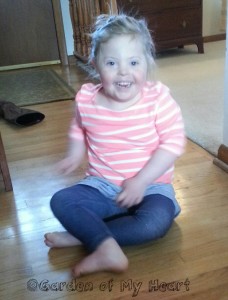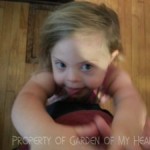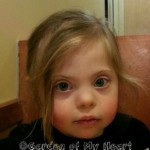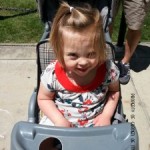As Autism Awareness Month draws to a close, I thought I would post about why we pursued further testing and what autism looks like for Rowenna.
Disclaimer: we are still learning about autism and Down syndrome. For resources, please check out The Down Syndrome-Autism Connection and this fantastic book about the dual diagnosis. For a layman’s description of the dual diagnosis, check out Courtney Heigele’s blog post over at Pudge and Biggs. (Then stay and read some other stuff because she’s fantastic.)
The other day I was speaking with a fellow Down syndrome mom about Rowenna’s diagnosis. As I was describing some of the things that led us to pursue testing, I could see the wheels turning in her head: does her child have autism, too?
It can be a bit of a puzzle to determine if a child has “just” Down syndrome plus a few characteristics from the spectrum or if the child does have a true dual diagnosis. Certain characteristics of autism are quite common in Down syndrome, such as sensory processing issues.
When we started this journey with Rowenna, we were primarily concerned with a regression in speech and an increasing inability to bounce back from challenging situations. It was also becoming harder to ignore how different Rowenna seemed than her peers – both with Down syndrome and without.
We pursued testing through a Down syndrome clinic not knowing what the final outcome might be, though I suspected we would eventually receive the autism diagnosis. Rowenna had a series of evaluations for speech, social, and play skills followed by an autism evaluation.
I’ve had a few people ask why we bothered exploring the possibility of a second diagnosis. For us, the answer was clear: she learns differently than the average child with Down syndrome. Until we had the diagnosis in hand, we heard repeatedly that we just “needed to give her time” and that she had Down syndrome so we should expect delays. While it’s true that delays are typically part of the Down syndrome package, Rowenna is struggling with things that are impeding her ability to learn. School was looking at the end result and recommending we give her time; it is now clear that this is not just a delay, but something requiring a totally different approach. Her diagnosis helps us guide the approach.
There’s also the logistical issues involved. Having an official autism diagnosis opens doors for Rowenna, including insurance coverage where it would be otherwise denied.
I hear parents worry about sensory issues (either avoidance or seeking behaviors) and repetitive play being signs their child is also on the spectrum. While those things are common on the autism spectrum, on their own they are not indicative of autism in Down syndrome.
When all was said and done with the evaluation process, the following things were part of her diagnostic criteria:-inability to make or hold eye contact
-did not point to items of interest or look in the direction of someone else pointing
-did not “share joy” (in other words, she did not invite others into her excitement; if we got excited with her, that was fine but she never got our attention to show she was excited)
-inappropriate play with toys and resistance to being shown the purpose of toys (for example, banging a doll on the wall versus cuddling a doll)
-abnormal difficulty with transitions
-significant regression in speech/communication skills
-speech/communication skills lagged far behind her other skills (fine and gross motor, problem solving, etc)
The final evaluation was a bit rough. We had no idea Rowenna was struggling with some basic play skills and we didn’t realize the extent to which she remained disengaged from people around her. She has always been friendly, she has always been curious, but I had no idea the extent to which she was in our world while holding us outside her own.
But ultimately it was a relief to receive the diagnosis and have a clear path set before us. We straddle two worlds and don’t truly fit in either one. We are not alone, though, and the online community of parents raising kids with a dual diagnosis is growing.
Rowenna has been receiving intensive, in-home therapy for 7 months now and we have already seen incredible gains. The world is becoming a bit more accessible, and for the first time in such a long time we are hearing her sweet voice again.
So if you are out there, on the fence, wondering whether or not to pursue testing for a possible dual diagnosis, I hope Rowenna’s story helps. She thrives with the care she receives due to that formal diagnosis. The words on the page don’t change our deep love for her, but it does open doors. We are so glad we pursued this diagnosis.
Happy Autism Awareness Month to our fellow autism families. We are proud to walk beside you.









Comments are closed.